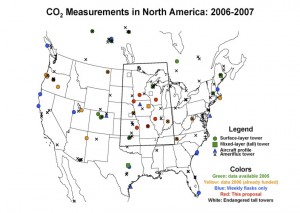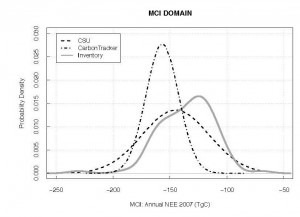NOAA Regional Inversions
Data fusion to determine North American sources and sinks of carbon dioxide at high spatial and temporal resolution from 2004 to 2008
NOAA 2008-2011
 There is strong evidence that North America terrestrial ecosystems are currently a substantial sink of carbon dioxide. The magnitude of the sink has a large range of uncertainty, we have a limited understanding of how it has varied over time, and the processes responsible for this sink are not entirely clear. Our limited understanding is linked to methodological limits, as well as limited continental data. Quantifying spatial patterns and temporal variability of carbon dioxide sources and sinks at continental to regional scales remains a challenging problem.
There is strong evidence that North America terrestrial ecosystems are currently a substantial sink of carbon dioxide. The magnitude of the sink has a large range of uncertainty, we have a limited understanding of how it has varied over time, and the processes responsible for this sink are not entirely clear. Our limited understanding is linked to methodological limits, as well as limited continental data. Quantifying spatial patterns and temporal variability of carbon dioxide sources and sinks at continental to regional scales remains a challenging problem.
In response to this challenge a rapid expansion of the N. American carbon cycle observational network is underway. This expansion includes a network (AmeriFlux) of continuous, eddy-covariance based CO2 flux measurements and a network of continuous, continental CO2 mixing ratio observations of comparable precision and accuracy to the marine flask network. Inverse studies of the N. American carbon budget have only begun to utilize these emerging data sources directly (i.e. tower fluxes and continuous continental mixing ratio observations), and how to best utilize these data together is a topic of great uncertainty and intensive research. This is the focus area of our proposal.
We propose to continue a program of research that will turn the emerging wealth of data in N. America to our advantage. This will be accomplished by a continued collaboration between research groups at the forefronts of terrestrial boundary layer CO2 flux and mixing ratio observations, and high resolution, land-atmosphere carbon cycle modeling. This collaboration has resulted in substantial progress towards fusion of flux and mixing ratio observations in a coupled land-atmosphere data assimilation framework. This project will further develop methods for fusion of CO2 flux and mixing ratio observations via inverse modeling incorporating the N. American CO2 mixing ratio observational network, forwards modeling built upon the N. American flux network, and cross-evaluation of these two approaches. Further, we will apply the methods already developed via this collaborative effort to examine interannual variability of N. American carbon fluxes from 2004 to 2008.
The research will address the following hypotheses: 1) Flux and mixing ratio observations can be merged into a consistent analysis at synoptic, seasonal, and interannual time scales; 2) The N. American CO2 budget will be well constrained by our data analysis system; 3) The 2004-2008 record of N. American net annual terrestrial CO2 fluxes will show a persistent net sink of carbon of location and magnitude consistent with previous estimates based on ecological inventory methods, and; 4) The same flux record will yield detectable, spatially-resolved, climate-driven interannual variability. Expected products include: 1) a growing database of flux-tower based, continuous CO2 mixing ratio observations suitable for application to continental inversions; 2) a comprehensive analysis system for estimation of monthly CO2 exchange across N. America at high spatial resolution; 3) significant reduction in the uncertainty in the annual net N. American CO2 flux and its interannual variations, and; 4) spatially and temporally resolved terrestrial CO2 fluxes and uncertainty estimates for 2004 through 2008 encompassing all of N. America. Ultimately, the results will support the development of dynamic predictions of the future carbon cycle by providing a regionally and temporally resolved multi-year record of whole continent terrestrial carbon fluxes needed to evaluate continental-scale models.


